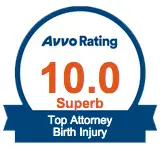Our Frequently Asked Questions
Answers to Your Questions on Birth Injury, Pregnancy, Disability, and Birth Trauma Law
There are many uncertainties for families coping with the diagnosis of cerebral palsy, developmental disabilities, hypoxic ischemic encephalopathy (HIE), and other serious conditions caused by birth injuries. Educating yourself and family members on the diagnosis, resources available, and options for securing your child’s future is critical. To help you get started, here are some answers to frequently asked questions about birth injuries and birth injury lawsuits.
Unusual infant head shapes can be caused by a number of factors, including traumatic pressure on the head in utero or during delivery, regular sleeping position, or rarely, genetic abnormalities. Depending on what type of head deformation an infant has, doctors may recommend allowing it to resolve itself with time, minor non-invasive interventions, or major...
The long-term effects of neonatal brain injury vary by the type, nature, and extent of the baby’s brain damage. Initial birth injuries and neonatal brain injuries that can lead to long-term effects include fetal oxygen deprivation and hypoxic-ischemic encephalopathy (HIE), brain bleeds (intracranial hemorrhages), fetal strokes, neonatal sepsis (infection in the blood), jaundice and kernicterus (high bilirubin levels), and neonatal...
As soon as a baby is born, the medical team usually draws blood from the baby’s umbilical cord artery. This blood is analyzed to determine if there was a complication shortly before or during delivery that deprived the baby of oxygen. Oxygen deprivation (birth asphyxia) can cause brain damage, hypoxic-ischemic encephalopathy (HIE), periventricular leukomalacia (PVL –...
Law and medical ethics dictate that medical professionals must obtain informed consent from their patients before beginning a treatment or procedure. Informed consent is based on 1) the patient understanding their treatment options and 2) the patient making a free choice. This requirement is meant to protect patients against unwanted medical interventions and to ensure...
Standard of care can be defined as how a reasonably competent medical professional or hospital would treat a certain type of patient or condition under the same or similar circumstances. Medical professionals receive a great deal of training and should have extensive knowledge regarding various medical conditions and treatments. In caring for patients, they must...
Why would a patient want to obtain medical records? Medical records, also known as health records, include all of a patient’s documented medical care and history as collected by a medical facility. (1). These include doctor’s notes, test results, billing information, lab reports, and more. As a patient, you may want to view and obtain...
Upon receiving a birth injury diagnosis, many parents are left wondering what their next step should be. If you suspect that the birth injury was caused by medical malpractice, it may be wise to hire an attorney. A good birth injury attorney can obtain the financial recovery necessary to pay for the numerous expenses associated...
Typically, a birth injury case will take between eighteen months to two years from the time the lawsuit is filed until the case either reaches a settlement or goes to trial. This timeline varies depending on a number of factors, including the state and county where the lawsuit (or “claim”) is filed, the extent of...
Research shows that shoulder dystocia can result in birth asphyxia and hypoxic-ischemic encephalopathy (HIE), a form of permanent brain damage that occurs when babies are deprived of oxygen during or near the time of labor and delivery. The longer a baby goes without sufficient oxygen, the more likely it is that the brain damage will be severe. ...
Hypoxic-ischemic encephalopathy (HIE) can often cause intraventricular hemorrhaging. When a baby sustains an oxygen deprivation-related injury (whether it is from trauma, misuse of assistive instruments, mismanaged umbilical cord issues or undiagnosed maternal health issues), it can result in brain bleeds. What is Intraventricular Hemorrhage (IVH)? The brain has four ventricles, which are spaces filled with...
An intracranial hemorrhage (brain bleed) is a traumatic or hypoxic birth injury characterized by sudden, rapid bleeding within the infant’s skull or brain. Extracranial hemorrhages, which are similar to intracranial hemorrhages, are characterized by bleeding just outside the skull. Causes and risk factors for brain bleeds vary depending on the type and location of the brain bleed. Common...
Infant brain hemorrhages (brain bleeds) encompass a variety of conditions with differing degrees of risk. Certain types of brain bleeds are very small and may not have long-term effects. However, if a brain bleed is severe and/or poorly managed, permanent damage can occur to the brain and cause long-term effects on important areas related to...
Yes. Electronic fetal monitoring is critical not only in labor and vaginal delivery but also during Cesarean sections (C-sections). When performing a C-section, medical professionals must ensure that fetal heart rate monitoring is done as continuously as possible. Sometimes there is an interruption in fetal monitoring from the time when the monitor is removed (which...
Delayed C-section deliveries can cause forms of brain injury, such as hypoxic-ischemic encephalopathy (HIE) or cerebral palsy in a baby. The American College of Obstetricians and Gynecologists (ACOG) has established a decision-to-incision time (time within which a cesarean delivery should take place after an emergency sign presents) of 30 minutes or faster (1). In the...
Cerebral palsy’s impact on a person’s lifespan depends on the severity of the diagnosis and availability of high-quality medical care and therapy. With milder cases of cerebral palsy, life expectancy may be completely normal or near normal. For those who are able to walk unaided, life expectancy has been estimated at 70-80 years for females...
Hypoxic-ischemic encephalopathy (HIE) can cause cerebral palsy (CP), though the two do not always appear together. Brain damage from HIE can manifest in several different ways, including cognitive impairments, vision and hearing issues, and motor difficulties. Cerebral palsy is a disorder that is characterized by a lack of motor function; it may arise in children...
Cerebral palsy (CP) is a condition associated with birth injury. It is a term used to describe a number of disorders affecting brain function and body movement. It specifically affects muscle, motor, and coordination skills. The symptoms can vary depending on the type of CP – from involuntary spasms to lack of muscle tone throughout...
The birth of a child is one of the most exciting moments for parents. But this excitement can be coupled with confusion and sadness if the baby suffers a birth injury, which is an injury that occurs during or near the time of delivery. When a birth injury occurs, a baby may sustain brain damage...
Jaundice, the yellowing of the skin caused by a buildup of bilirubin (the product of red blood cell breakdown) in a baby’s blood and tissues, is often harmless when treated properly. However, when the level of bilirubin in a baby’s blood rises to a dangerous level, bilirubin can enter brain tissue. Bilirubin is toxic to...
Cerebral palsy (CP) is a group of motor disorders caused by an injury or abnormality in the parts of the brain that control movement. While some cases of CP are congenital (exist at birth or inherited), many are caused by preventable birth injuries. In these situations, the child likely would not have developed cerebral palsy...
Because the severity and side effects of cerebral palsy (CP) can vary so greatly, there is no single way to determine if a child has it. Common signs of cerebral palsy in newborn babies include muscular stiffness, limpness, difficulty feeding, seizures, and more. In some cases, medical personnel recognize these clinical signs and diagnose cerebral...
Cerebral palsy (CP) is a type of motor disorder that can result from brain damage or abnormalities. In many cases, it is caused by a birth injury; that is, a complication or medical error shortly before, during, or after birth. Cerebral palsy is typically diagnosed in babies and toddlers between 18 and 24 months of...
Spastic cerebral palsy (CP) is a disorder that causes problems with movement and balance due to a brain injury that occurs during or near the time of labor and delivery. Sometimes cerebral palsy is noticed soon after birth, but in other children, the disorder won’t be noticed until a few years later. Babies with cerebral palsy...
Children should attend well visits with their pediatrician, where their development will be monitored. This monitoring is important for all children, but especially those who are at risk for developmental issues (i.e. if they were born prematurely or at a low birth weight (1). If the doctor is concerned, developmental screenings should be done. Developmental screenings...
Assistive technology describes any item, program, or system used to improve or maintain function for people with disabilities. People with cerebral palsy (CP), hypoxic-ischemic encephalopathy (HIE), cognitive impairments, and various birth injuries may require assistive technology to complete daily tasks. The term covers a broad range of items, from low-tech tools like weighted pens, to...
Occupational therapy is a critical part of any cerebral palsy treatment program. The goal of occupational therapy is to promote a patient’s ability to perform daily activities in a way that will enhance quality of life and increase independent living skills. During an occupational therapy session, the therapist will guide the patient in adapting, compensating for their limitations,...
Physical therapy is aimed at promoting the motor and developmental skills of a child with cerebral palsy. The child’s parent or caregiver should be taught the exercises or activities that are necessary to help the child reach his or her full potential and improve function. Physical Therapy for Cerebral Palsy: Techniques and Effects Daily range-of-motion...
Cerebral palsy (CP) is a non-progressive, neurological condition that often causes physical disabilities, cognitive impairments, epilepsy, and other complex health issues. While there’s no cure for cerebral palsy, medication can help alleviate many of the side effects. Medicines are commonly prescribed in order to control seizures, spasticity, and pain; however, because each case of cerebral...
A femoral osteotomy is a surgical correction done on many children with subluxation or dislocation of the hips due to cerebral palsy. Subluxation is when the ball of the hip slowly pulls out of its position in the socket. Dislocation is when the ball completely comes out of the socket. This procedure may also be called...
Children with cerebral palsy may develop a problem called hip subluxation, in which the hip becomes partially dislocated. To alleviate pain, improve function, and prevent full dislocation, physicians may recommend a procedure in which muscles and tendons in the leg are “released,” or lengthened. What Is Hip Subluxation? When a hip is subluxed, that means...
There are numerous treatments and therapies for spastic cerebral palsy. These include therapeutic treatments, supportive treatments, surgical interventions, and medical interventions. These therapies are usually combined for maximal effect as part of a comprehensive treatment plan. What forms of spastic cerebral palsy do treatments address? Spastic cerebral palsy is the most common type of cerebral...
A child’s development can be impacted in numerous ways depending on the severity, location, and extent of the brain damage that caused the cerebral palsy. Generally, the developmental categories that can be impacted by cerebral palsy include gross motor movement and fine motor coordination. Birth injuries that cause cerebral palsy can also cause problems with...
Research shows that shoulder dystocia can result in birth asphyxia and hypoxic-ischemic encephalopathy (HIE), a form of permanent brain damage that occurs when babies are deprived of oxygen during or near the time of labor and delivery. The longer a baby goes without sufficient oxygen, the more likely it is that the brain damage will be severe. ...
Forceps, an instrument that looks a bit like a pair of tongs and is used to facilitate vaginal delivery, can cause birth injuries when incorrectly used. Physicians must be very careful to properly apply forceps and to not excessively press or pull on the baby’s head. As each contraction occurs, the obstetrician is supposed to...
Pitocin (synthetic oxytocin) and Cytotec (synthetic prostaglandin) are used to speed up the process of labor. Both of these drugs can cause a condition called uterine hyperstimulation (alternative terms include tachysystole and hypertonus). Hyperstimulation occurs when these drugs cause contractions to be too frequent, strong, or long-lasting. When the placenta and uterus are under continuous...
Hypoxic ischemic encephalopathy (HIE), or birth asphyxia, can result in long-term physical, mental, and cognitive problems. Usually, HIE is diagnosed early. Other times, however, the brain damage from HIE is not discovered until years after the hypoxic event, when a child fails to meet certain developmental milestones. The severity of the disabilities is dependent upon how...
Hypoxic-Ischemic Encephalopathy (HIE), also known as ‘birth asphyxia,’ is a dangerous neonatal brain injury. HIE occurs due to oxygen deprivation and/or compromised blood flow to the brain. When this happens, brain cells die off in a cascade reaction, causing widespread brain damage. If the issue is addressed very quickly after birth, however, the damage can be...
Babies do not exactly “breathe” in the womb; at least not by inhaling air they way they do after delivery. Instead, oxygen travels through the mother’s lungs, heart, vasculature, uterus, and placenta, finally making its way through the umbilical cord and into the fetus. Interruptions in the Oxygen Pathway: Birth Injuries During labor and delivery,...
Hypoxic-ischemic encephalopathy (HIE), sometimes referred to as birth asphyxia, is a neonatal brain injury caused by an insufficient flow of oxygen-rich blood. There are a variety of factors that may lead to HIE, including maternal health issues, labor and delivery complications, infections, improper fetal monitoring, or failure to provide needed intervention (such as an emergency...
Hypoxic-ischemic encephalopathy (HIE) is generally diagnosed by a physician once signs of oxygen deprivation (birth asphyxia) become evident. The diagnosis is typically based on a combination of medical history, physical and neurological exams, laboratory results, and neuroimaging. Many of these tests and studies assess brain injury severity and evaluate the status of the baby’s organ...
When untreated or improperly treated, urinary tract infections (UTIs) and bacterial vaginosis (BV) can both be very dangerous to an unborn baby. UTIs and BV can cause several types of obstetrical complications and birth injuries, including preterm delivery, sepsis, meningitis, hypoxic-ischemic encephalopathy (HIE), and cerebral palsy (CP). Note: for more detailed information about UTIs and...
Pitocin (synthetic oxytocin) and Cytotec (synthetic prostaglandin) are used to speed up the process of labor. Both of these drugs can cause a condition called uterine hyperstimulation (alternative terms include tachysystole and hypertonus). Hyperstimulation occurs when these drugs cause contractions to be too frequent, strong, or long-lasting. When the placenta and uterus are under continuous...
A: Yes. It is common for physicians to use medications to induce or speed up labor. Pitocin and Cytotec are the most common labor induction medications. However, if misused, these drugs can cause birth injuries such as hypoxic-ischemic encephalopathy (HIE) and brain bleeds, which can lead to cerebral palsy. Utilization of medications to start and...
A. Yes, they often do. Newborn, neonatal seizures occur shortly after birth or during the following hours and days and can indicate that a birth injury occurred. In fact, seizures may be the first (and perhaps only) clinical sign of a brain injury in a newborn baby. Seizures frequently develop in babies who experienced...
A: Ultrasound testing for amniotic fluid volume is the best way to test for oligohydramnios. This test is conducted along with tests for the baby’s general well-being, such as the biophysical profile (BPP) and nonstress tests (NST). While ultrasound testing is the only clinically practical way to measure amniotic fluid volume, a test called the...
A: Under normal circumstances, the placenta (the structure that transports gases and nutrients between mother and child) remains attached to the uterus until after the baby is delivered. If there’s a placental abruption, the placenta separates too early (while the baby is not yet delivered), jeopardizing the health of both mother and child. Placental abruption can cause...
Preterm premature rupture of membranes (PPROM) is a subtype of Premature Rupture of Membranes (PROM). PROM is a condition in which a mother’s ‘water breaks’ (the amniotic sac and chorion rupture) more than an hour before the onset of labor. PPROM refers to when this happens before 37 weeks gestation – that is, before the...
Premature Rupture of the Membranes (PROM) is a complication occurring during pregnancy in which the mother’s membranes rupture (this is commonly referred to as the “water breaking”) more than an hour before labor begins. PROM puts unborn babies at risk of not getting enough oxygen because their umbilical cord becomes compressed, as well as becoming...
Fetal distress is an emergency pregnancy, labor, and delivery complication in which a baby experiences oxygen deprivation (birth asphyxia). Signs of fetal distress may include: Changes in the baby’s heart rate (as seen on a fetal heart rate monitor) Decreased fetal movement Meconium in the amniotic fluid (increasing risk for meconium aspiration) Medical staff should...
When a woman first becomes pregnant, the amount of information given to her about prenatal care may be overwhelming. Throughout this page, our birth injury team will explain the prenatal tests (also known as antenatal tests) that physicians perform to ensure the health and proper development of a newborn baby. The main goal of these...
Choosing an obstetrician is an exciting, personal, and important start to a pregnancy. While most pregnancies result in healthy babies, dangerous complications can arise during pregnancy, labor, and delivery that can cause permanent, devastating injuries to the mother and/or baby. Given the extreme consequences of mishandled complications, it is important for parents to play a proactive role in...
Research shows that shoulder dystocia can result in birth asphyxia and hypoxic-ischemic encephalopathy (HIE), a form of permanent brain damage that occurs when babies are deprived of oxygen during or near the time of labor and delivery. The longer a baby goes without sufficient oxygen, the more likely it is that the brain damage will be severe. ...



















